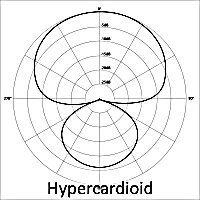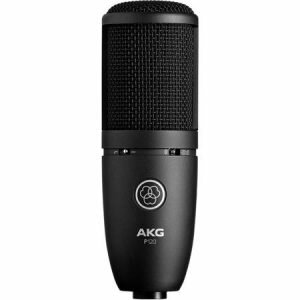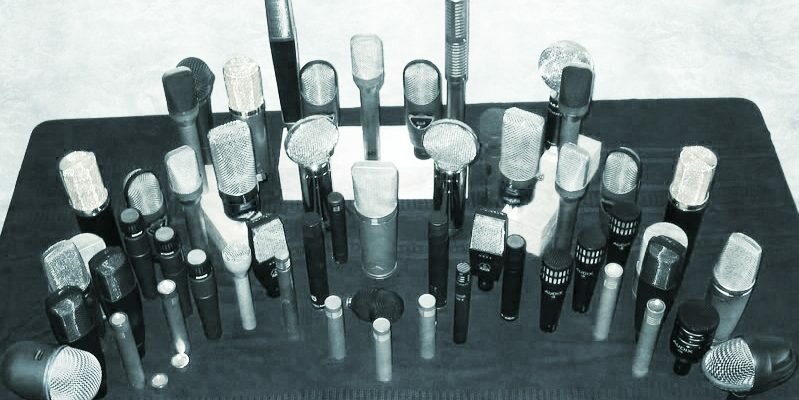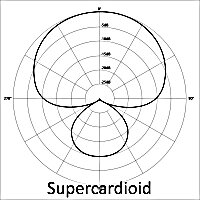Mics are important pieces of equipment used in music production, both live and recording and in this article, we will be looking at the main types of mics used in music production and what they are typically used for.
Contents
The Different Microphone Polar Patterns
One of the first things to consider when picking up mics is the polar pattern found on them.
Polar patterns describe how microphones pick up sound showing the specific places where mics are listening and which positions are blocked. Having a good understanding of these polar patterns will help you select the right mic, capture the sound you need and minimize unwanted noise. Mics categorized according to their polar patterns are:
Cardiod Microphones
These mics capture everything in front and block everything else. Their front-focused pattern will allow you point the mic to a sound source and isolate it from unwanted ambient sound and this makes it ideal for live performances and other instances where noise reduction and feedback suppression is required. Cardioid mics are more reputable than other polar patterns, both regarding popularity and use as they can be used about anywhere, from karaoke to big arena concerts. Other common uses of these mics are in talking drum kits and guitar speakers.
It must be noted that these kind of mics add subtle sound coloration when the source is off axis, this is why positioning is very important when singing or speaking with a mic.
Supercardiod Microphones

These microphones benefit from a higher resistance to feedback and have improved sound isolation.
Omnidirectional Microphones

In movies, omnidirectional microphones are best suited for lavaliers as they give you the freedom to clip the microphone on your subject from any direction while providing you with the additional benefit of consistent sound levels even if your subject moves their head side to side.
Figure 8 Microphones

You could also think of these as omnidirectional mics but with sound rejection from both sides.
Shotgun Microphones

These mics are perfect for filmmakers especially when they want to record a dialogue in a scene where they don’t want the mic visible in the shot. This requires you place the mic a certain distance away, out of frame, often above the actor on a boom pole.
Switchable/Multi-Pattern Microphones
These are mics which can switch between different polar patterns, allowing for versatile placement. Several USB condenser microphones have this feature, allowing you switch between multiple patterns simply by flicking a switch. Others provide the same flexibility just by changing the mic head, and they are great because they offer more positioning possibilities and more usage.
Diaphragm Sizes
Microphones pick up sounds through their diaphragm, a thin material that vibrates when it comes in contact with sound. This vibration converts sonic energy into electrical energy. While there is no standard unit for measuring diaphragm sizes, there are three main classifications. The size of a microphones diaphragm affects its sound pressure level handling, dynamic range, sensitivity and internal noise level.
Small Diaphragm

They are very popular when it comes to recording acoustic guitars, cymbals, hi-hats and other instruments. You can also get a matching pair and use them both at the same time recording from different angles – this is particularly common for recording acoustic guitars. Major limitations of these mics are a low sensitivity and increased internal noise.
Large Diaphragm

This fidelity makes large diaphragm mics a staple in recording studios and is the most common configuration used on modern USB mics. They can be used to record just about anything, from vocals to guitars and other instruments, just ensure you keep the volume in check as it can distort when sound pressure level is increased.
Medium Diaphragm

These are modern microphones which are gaining a reputation in both live and recording sessions, but basically, you can skip on these mics if you are setting up a small home studio or a small venue, especially when you already have large and small diaphragm mics.
The Three Types Of Mics Used In Music
There are the three different types of microphones commonly used in music, available with either XLR or USB connectivity and they include:
Dynamic
If you need something reliable and versatile, then you should consider going for a dynamic microphone. Due to their moving coil magnetic diaphragm, these mics can reliably capture sound and do so at higher sound pressure levels. Therefore you can use them for miking loud sound sources such as bass and guitar amplifiers, and even drum kits without having to worry about unwanted distortion or damage. Finally, they work as well in high sound pressure level settings as they do in quieter settings.
Condenser
Condenser mics have a thin conductive diaphragm which sits close to a metal backplate. This configuration works like a capacitor wherein sound pressure vibrates on the diaphragm then changes the capacitance to produce audio signals. Since they work with capacitance and not actual moving coils, the sound quality is improved, making these mics ideal for precision recording in studios.
Ribbon
These mics may not be very popular today, but there was a time they were very successful, particularly in the radio industry. The light metal ribbon used in these mics allows them to pick up the velocity of the air and not just air displacement. This allows for improved sensitivity to higher frequencies, capturing higher notes without the harshness while retaining that warm vintage voicing. These days, ribbon mics are coming back into popularity slowly especially as they are now sturdier and more reliable than their older counterparts, making them viable for live multi-instrument recording in venues where the sound in manageable. You can also use them to get that vintage vibe during recording sessions or set it up in combination with dynamic or condenser mics for more open soundtracking.
The Main Practical Applications For Different Microphones
Below we take a look at the main purpose of each kind of microphone to get you started. It’s likely you would find additional applications for each mic which would work for you.
Vocals
Cardioid mics work best for live vocal performances where stage volume can get loud, and feedback suppression is vital. Recording vocals, on the other hand, is a different activity which requires more attention to the features unique to the singer therefore large diaphragm condensers work best. If you choose to go with more vintage vocal recording, then you should go with ribbon or dynamic mics. Also, you can use a shotgun and small diaphragm omnidirectional mics when capturing choir and singing groups especially in acoustic locations like churches.
Drums
Because drums are naturally loud and punchy, you should consider going with dynamic cardioid mics for the snare, bass, and toms. Small diaphragm mics would work fine in capturing the peculiarities of the hi-hat, ride, and cymbals. To get the best results, there are specialized mics designed to handle the different frequencies and SPLs of each part of a drum kit; you can either get them one after the other or go for convenient drum kit mic bundles.
Electric Guitar Amps
Close mic’d guitar amplifiers can be as loud or even louder than drum kits. Therefore, they require mics that can handle high SPL. For these setups go for cardioid or hyper-cardioid dynamic mics positioned properly in front of the amp speaker. You should go with a second condenser mic or ribbon mic placed at a distance when using multiple amps or if you require a warmer, more classic sounding output, or in combination with a close mic to capture the ambience in the room.
Acoustic Guitars
When not amplified, acoustic guitars have softer sounds with immersive nuances. These instruments require the quality of large diaphragm condenser mics. You could also go for a well-positioned cardioid condenser mic or a figure-8 pattern ribbon depending on the situation and noise level. Finally, setting up an extra small diaphragm works wonders in capturing higher frequencies which would otherwise get lost when acoustics are plugged in.
To Summarise
We have just looked at the main types of microphones you will see in various situations, however as you gain more experience you would learn how to adapt and appropriate mics to your specific needs.








Leave a Reply